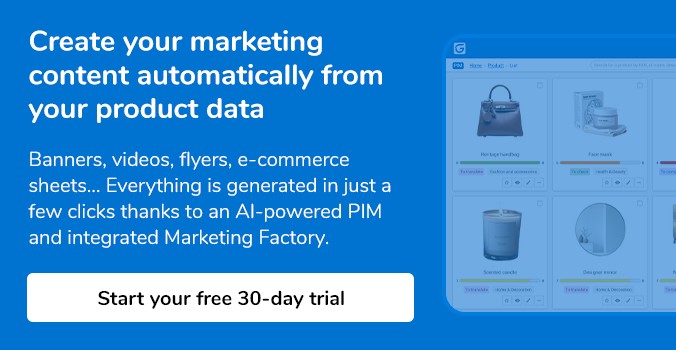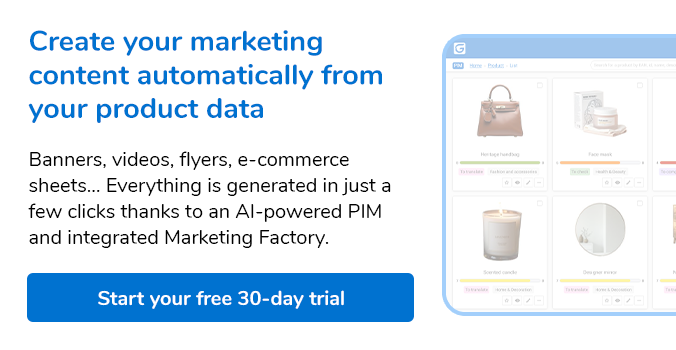Competition keeps increasing and innovation has become the « new battle ground1» for businesses.
Companies are therefore equipping themselves with solutions specifically designed to accelerate the time to market of their products and to make them as competitive as possible. The two main solutions are PIM (Product Information Management) and PLM (Product Lifecycle Management).
PIM and PLM are two very different solutions catering to distinct business needs. Used together, they become a true competitive advantage for businesses.
Find out what makes each solution different and how to use them together to remain competitive on the market.
#PLM, definition and advantages
#What is PLM?
Throughout a product's lifecycle (design, development, production and manufacturing…), businesses come up against numerous challenges: 71% of businesses2 are insufficiently prepared for the increasing complexity of products and production processes. Among the main challenges facing them: multiple demands for technical modifications, lack of collaboration between teams (R&D, production, organization and methods, quality…), the endless evolution of international regulations…
Using PLM (Product Lifecycle Management) has become essential to rise to these challenges. PLM solutions centralize all the data generated throughout the product lifecycle (CAD files, components, documents, product glossaries, technical specifications…), and federate teams around a shared tool enabling them to depend on a « reliable, unique and secure » information system at all phases of the product lifecycle.
#The benefits of PLM
#Optimize the process of managing modifications
It is indispensable to make changes to your products to keep them evolving: update technical features, revise CAD files, adapt information to new regulations… However making these changes individually or in isolation has many drawbacks (lack of visibility of the impact of each change made, input errors and inconsistencies, lack of traceability…).

Product Lifecycle Management (PLM) solutions optimize this information management process with their specific features for helping teams to optimize their tasks: validation workflow, management of successive versions, impact analysis… These solutions can reduce the time spent on these processes by 60%2 and allow you to access up to date information at every stage of the product lifecycle.
#Reduce the time to market
Competition is increasingly fierce and the volume of new products constantly increasing. To remain competitive, businesses have to intensify their efforts and ramp up their innovation capabilities: 61% of businesses4 have added smart products to their catalogs.
PLM (Product Lifecyle Management) solutions improve the overall efficiency of product development, boosting your responsiveness and reducing the time to market of products by up to 30%5. PLM solutions are helping to improve the « right time to market » by facilitating the time to market6 of the right product at the « right time ».
#PIM, definition and advantage
#What is PIM?
Businesses often use several different applications for managing product information: ERP, CRM, Excel files… This fragmentation of data and the lack of collaboration between teams (Product, Marketing, SEO, eCommerce…) is often the source of errors in the information presented to the customer: inconsistencies, input errors, data duplicates…
This makes using PIM a necessity and 74% of businesses7 that have implemented a PIM solution have noticed a reduction in errors in product information and 61%7 have witnessed a decided improvement in the customer experience.
PIM (Product Information Management) solutions greatly improve the quality of product information. PIM centralizes all product data: prices, technical features, sales pitches, descriptions… This way teams can constantly rely on a unique product repository containing reliable and up to date product data. PIM's collaborative features mean that they can also work together on improving the quality of product information (enrichment, adaptation to each selling channel, translation…).
#The benefits of PIM
#Reassure shoppers
Consumers want to find as much information as possible before making their purchases and expect to access reliable and up to date product information (prices, technical features, sales pitches, product descriptions…). If this information is inaccurate 87% of them8 will not buy the product.
PIM (Product Information Management) solutions give your full control over the quality of product data before distribution. Their workflow and validation features let you organize the rights and roles of each contributor. Depending on these rights, each contributor can correct product information and ensure that it is sufficiently qualitative before its distribution on all selling channels: point of sale, print, eCommerce, social networks…
#Generate positive emotions
To persuade a shopper to buy, it is vital to generate positive emotions throughout their shopping journey. Among the main obstacles9 to online shopping: not being able to try on, touch and/or handle a product.

PIM lets you show shoppers product pages creating a strong link with the product. Its multi‑user management features enable several teams to intervene during the product information enrichment phase: add 3D and 360° photos, use storytelling to complete a description, insert a video of the product in use… Adding this sort of content is imperative and increases sales significantly according to 78% of marketing professionals10.
#PIM and PLM are solutions that meet different business needs
PIM and PLM are two very different systems providing solutions to distinct business issues.
At the heart of the sales and marketing strategy, PIM is specifically designed for marketing professionals and enables them to present reliable, enriched and up to date product information on all selling channels.
PLM on the other hand, has no impact on the information presented to the customer and is confined to the company's internal processes. At the heart of their innovation strategy, PLM is intended more specifically for R&D teams and manufacturers and provides a solution to specific business needs in varied activities: chemicals or agri-food (formulas or recipes), textile (collections and brands), aeronautics (parts and components)…
#Combine PIM and PLM for a real competitive advantage
Used together, PIM and PLM help businesses to remain competitive on the market.
Marketing professionals can use the information and documentation contained in the PLM to improve their understanding of products and sell them better. For example, they can improve the sales pitches on product pages and/or use their knowledge to provide detailed answers to shoppers' questions.
R&D teams and manufacturers can use the information contained in the PIM to adapt their products more precisely to the expectations of shoppers. One example is accessing customer reviews to identify their preferences and take them into consideration to improve existing products and/or develop new products.
1
Gestion du cycle de vie des produits. www.oracle.com.
2
Study “Future PLM”. bearingpoint.com.
3
PLM – Product Lifecycle Management. lascom.com.
4
Product Lifecycle Management in the digital future. bearingpoint.com.
5
Mezouar, F. Le PLM, l'accélérateur des biens de grande consommation et distribution. capgemini.com.
6
Blanc, S. & Legrand, C. (2023, March). Les promesses du PLM. lesechos.fr.
7
Why is a PIM beneficial for your e-commerce team ? (2022, August 18). ergonode.com.
8
Sansonetti, J. Comment rédiger une fiche produit qui convertit à coup sûr ? 10 Conseils (+2 Bonus). wizishop.fr.
9
Laurent, S. (2021, August 13). Reduce the barriers to online shopping to increase conversions.
10
Mohsin, M. (2022, April 13). 10 Video marketing statistics that you need to know in 2022 [INFOGRAPHIC]. oberlo.com.







